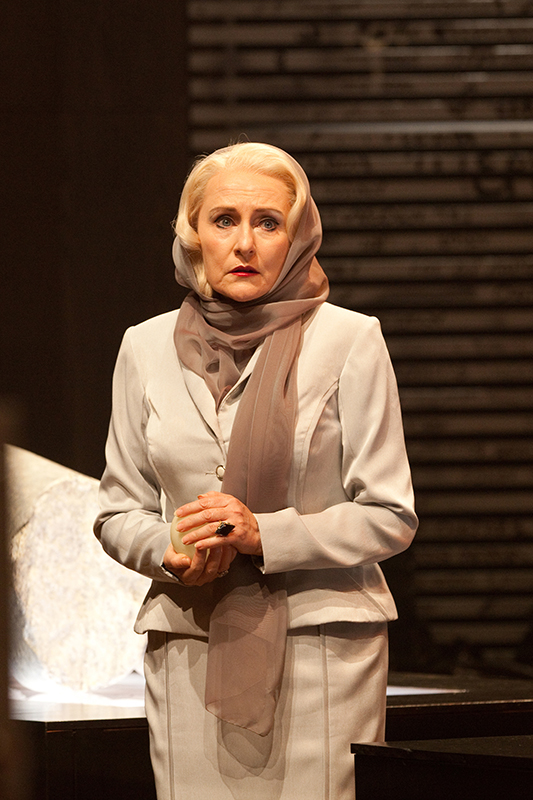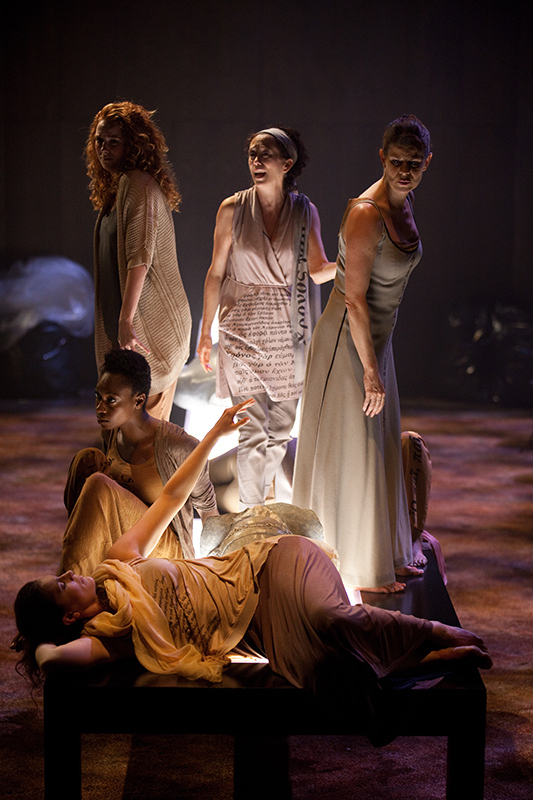Sophocles' Elektra
Translated by Anne Carson
Directed by Thomas Moschopoulos
Tom Patterson Theater
Stratford Shakespeare Festival
Stratford, Ontario
July 29 to September 29, 20121
Review by Dana E. Aspinall
Alma College

Seana McKenna as Clytemestra. (Photo by Cylla von Tiedemann.)

From top, left: Jacquelyn French, Barbara Fulton, Monique Lund, Sarah Afful, Ayrin Mackie as Chorus of Women. (Photo by Cylla von Tiedemann.)
Although the jeremiads throughout Sophokles’ Elektra consistently inspire shock and sympathy in readers, and despite the fact that Anne Carson’s translation nearly always preserves the playwright’s devastating rhetorical power, it is director Thoms Moschopoulos’s visual and aural embellishments that audiences of the Stratford, ON, production this summer will remember most vividly.
Moschopoulos and designer Ellie Papageorgakopoulou combine ancient and modern props in their deployment of acting space, and create not only an air of foreboding but also discernible senses of deprivation and urgency: someone suffers unimaginable loss, and the environment redounds with pain and a demand for vengeance.
The rear of the stage denotes a filthy back alley: retracting steel door guards, overflowing trash bags, and graffiti-covered brick and wood. Nothing lives in this space, and the hazy dimness promises to stymie any entity that the steel and detritus cannot.
As the stage thrusts out into the theatre’s center, the lighting brightens, but only to limn more harshly some marble statuary fragments of what once constituted an idealized male body. Covered in plastic sheets, the fragments rest on three tables, as would bodies hurriedly autopsied and left for quick, emotionless disposal. Beyond the tables stretches a wire fence, which separates the audience from the stage, and, outside of that, a burial ground, with exposed, recently disturbed soil. Everywhere, then, and in every manifestation, the living and the growing succumb to cold, unregenerate death.
Even the human will, the soul, fixates itself upon the negation of life in this bleakest of Sophokles’ plays, and Moschopoulos capitalizes upon this fixation. Characters emerge literally from the lifeless props, and carry into the world their ruinous compulsions. Before the play begins, for example, Pylades, the Old Man, and members of the Chorus of Women intermingle with the ushers who surround the stage; as the audience settles, these characters describe to those in their proximity the backstories involving Agamemnon’s father Atreus, brother Menelaus, and sister-in-law Helen of Troy. Then, as the lights darken, these characters silently exit the stage or, as in the case of Pylades, ascend onto it and become part of the scene.
The effect is amplified once Pylades reaches the tables. Adorned in black, modern habiliments, Orestes’ loyal companion strips the plastic cover away from the center table and reveals Orestes, who wears only white boxer briefs and sleeps in a fetal position among the fragments. Pylades gently awakes him, picks him up as one would a child, and carries him to the Old Man, who will urge Orestes to action.
Many critics note the severe restrictions of movement to which Elektra accommodates herself. At the beginning, she can only wait for Orestes to avenge her father Agamemnon’s murder, and never rises above the grief and humiliation that her mother Clytemestra and stepfather Aigisthos impose when they murder Agamemnon and assume his throne in Argos. “I cannot not grieve,” she informs her Chorus of Women in memorable understatement, as she stands dressed in a manner ironically befitting a young, modern, and confident woman: gray sweater layered over a white blouse open at her neck, glasses, black skirt and shoes, and slightly disheveled hair. Acted, sung, and danced with aplomb by Yanna McIntosh, Elektra exudes energy and poise, and yet does nothing.
Throughout his interpretation, Moschopoulos intensifies the debilitating impact of immobility as he illustrates its ubiquitous nature: nearly every character grapples with confinement, a delimitation of his or her autonomy, and this shared experience propels each into a disregard for all life.
Most significantly, Moschopoulos foregrounds parallels between Orestes’ and Elektra’s predicaments. Where Elektra stagnates in suffocating inactivity—her only refuge the poetic laments she recites or sings to her Chorus—Orestes suffers a profoundly arrested emotional development, as witnessed during this first scene. His fetal sleeping position, the diaper-like white underwear, and Pylades’ hoisting and transporting of his body (he performs this function at other junctures in the play as well) all signal an emotional infancy, an absence of characterological growth since that day in his childhood when Elecktra rescued him from death. The idealized fragments he sleeps among on the table hint at the maturity he should possess at this point in his life, and his descent into the soil that covers his father’s grave when Elektra enters signifies a stubborn clinging to the womb.
Although she understands her situation more clearly than does Orestes, Elektra’s sister Chrysothemis also appears frozen in her personal development. Chrysothemis dresses fashionably, with sunglasses, a purse, and designer shoes, and thus consciously takes refuge in her wealth, one of the few advantages her mother’s actions afford her. Her refusal to assist Elektra in her vengeance—despite her earlier promise to “stand up” for herself—reflects her impulse to keep all matters in stasis. As Elektra suspects, her sister’s promise to help is “all words,” and, like her clothing, it only covers superficially and temporarily an ugly predicament with no precedent.
Clytemestra’s entrapment, as well as her cognizance of it, informs perhaps the most visually striking moment in the production. As Chrysothemis departs and the Chorus chants “Justice is coming,” the immense wooden doors at the back of the stage open and Clytemestra enters on a tall platform, drawn by two slaves. Dressed as a more decrepit embodiment of Chrysothemis, including a gray skirt and jacket, kerchief, sunglasses, obviously dyed blonde hair, and thick red lipstick, Clytemestra holds in one hand a glass sphere and clings to the platform rigidly—as if to prevent a fall—with the other. Although she asserts confidently that “I feel no remorse” for her adulterous relationship with Aigisthos or for her part in the murder of her husband, her unbalanced posture and gait belie this sureness. Only when informed of Orestes’ “death” by chariot crash does she express joy: “From now on, I pass my days in peace.”
Moschopoulos and choreographer Amalia Bennett underscore the ubiquity of these characters’ confinements through their manipulations of rhapsodia, or rhythmic recital, a technique they borrow from narrations of epic. When Elektra responds to Clytemestra’s explanation for her betrayal and murder of Agamemnon, for instance, she claps her hands to a beat; when the Old Man announces Orestes’ death to Clytemestra, he keeps the meter by pounding a stick on the ground as he speaks; and when the Chorus of Women interact with Elektra, they chant in rhythm and frequently utilize phonemes meaningful only through what they represent emotionally. Through this borrowing, Moschopoulos and Bennett create an aural experience that complements and enhances an already unusually rich visual undertaking.
note
1 Editor's note: Ruth Scodel reviews the same production in Number 11 of this volume.
